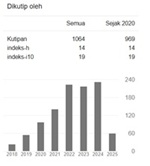PROFILE OF MATHEMATICAL COMMUNICATION’S ABILITY BASED ON LEVEL OF PROBLEM SOLVING’S ABILITY
Abstract
Abstract : This study was aimed to define profile of mathematical communication based on the level of problem solving ability on secondary students. This study used mixed methods model with explanatory type. This sample used 30 secondary school students who was chosen based on teachers’ recommendation. The result shown that there are 16,67% students whose problem solving’s ability were placed on low level If we look on mathematical communication ability’s side, most of students faced on the diffulties of projecting figures into mathematical ideas. Students still made mistakes on calculating and the indicators was difficult when it stated to project any figures into mathematical ideas while the indicator that appear frequently was stated events or ideas in mathematical laguage. There are 70% students that whose problem solving ability were placed on medium level. If we look on mathematical conection ability most of information as shown unclearly and faced on difficulties when they summarize conclusion, they stated it into mathematical symbol. There are 13,33% students whose problem solving ability were pleced on high level and unclear to every single information that was told within solving strategy which directly on solving essentials.
Keywords: Profile of mathematical Ability, Mathematical Communication, Problem Solving
Full Text:
PDFReferences
Ariawan, R., & Nufus, H. (2017). Hubungan Kemampuan Pemecahan Masalah Matematis dengan Kemampuan Komunikasi Matematis Siswa. Jurnal THEOREMS (The Original Research of Mathematics), 1(2), 82–91.
Asmana, A. T. (2018). Profil komunikasi matematika tertulis dalam pemecahan masalah matematika di smp ditinjau dari kemampuan matematika. Jurnal Inovasi Pendidikan dan Pembelajaran Matematika Volume, 4, 1–12.
Azwar,S.(2012). Penyusun Skala Psikologi.Yogyakarta:Pustaka Pelajar. 148-14
Novianti, D. E,& Khoirotunnisa, A. (2017). Profil Pemecahan Masalah Matematika Dalam Menyelesaikan Permasalahan Pemrograman Linear Ditinjau Dari Kemampuan Komunikasi Matematis.JIPM (Jurnal Ilmiah Pendidikan Matematika), 6(1), 53–59.
Fatimah, F. (2009). Kemampuan komunikasi matematis dan pemecahan masalah melalui problem based-learning, 249–259.
Irianti, N. P., & Chandra, T. D. (2016). Proses Berpikir Siswa Quitter dalam Menyelesaikan Masalah SPLDV Berdasarkan Langkah-Langkah Polya, I(2), 133–142.
Isvina, W. Y., Sugiarti, T., & Kurniati, D. (2015). Proses Berpikir Kreatif in Memecahkan Masalah Sub Pokok Bahasan Trapesium Berdasarkan Tahapan Wallas,according to from Adversity Quotient ( AQ ) Siswa Kelas VII-C SMP Negeri 1 Jember ( The Process of Creative Thinking to Solve The Problem of “ Trapezoid .” Artikel Ilmiah Mahasiswa, 1.
Nari, N. (2015). Kemampuan Komunikasi dan Disposisi Matematis Mahasiswa pada Mata Kuliah Geometri.Ta’dib, 18(137).
NCTM. (2007). Six Principles for School Mathematics. NCTM
Nunes, T., Bryant, P., & Sylva, K. (2009). Development of Maths Capabilities and Primary School.The University of Oxford.
Permata F, Kartono, S. (2015). Analisis Kemampuan Komunikasi Matematis Siswa Kelas VIIISMP pada Model Pembelajaran Tsts dengan Pendekatan Scientiic, 4(2).
Pratiwi, D. D. (2015). Analisis Kemampuan Komunikasi Matematis dalam Pemecahan Masalah Matematika Sesuai dengan Gaya Kognitif dan Gender. Pendidikan Matematika, 6(2), 131–141.
Rachmayani, D. W. I. (2014). Penerapan Pembelajaran Reciprocal Teaching Untuk Meningkatkan Kemampuan Komunikasi Matematis dan Kemandirian Belajar Matematika Siswa, 2(November), 13–23.
Rosli, R., Goldsby, D., & Capraro, M. M. (2017). Assessing Students ’ Mathematical Problem-Solving and Problem-Posing Skills, 9(16), 54–60. https://doi.org/10.5539/ass.v9n16p54
Sutiarso, S. (2017). Meningkatkan kemampuan komunikasi dan pemecahan masalah dalam pembelajaran matematika 1. Seminar Nasional Matematika dan Pendidikan Matematika, 289–295.
Umar, W. (2012). Membangun kemampuan komunikasi matematis dalam pembelajaran matematika.Journal Ilmiah Program Studi Matematika STKIP Siliwangi Bandung, 1(1).
Yeo, K. K. J. (2009). Secondary 2 Students’ Difficulties in Solving Non-RoutineProblems. International Journal for Mathematics Teaching and Learning.
DOI: http://dx.doi.org/10.53712/sigma.v5i2.647
Refbacks
- There are currently no refbacks.
Indexed by:
Published by Prodi Pendidikan Matematika FKIP Universitas Madura
Jl. Raya Panglegur Km 3,5 Pamekasan
Phone: (0324) 322231
website: http://http://ejournal.unira.ac.id/index.php/jurnal_sigma/index
Email: math@unira.ac.id

SIGMA by Universitas Madura is licensed under a Creative Commons Attribution 4.0 International License.

2.jpg)











